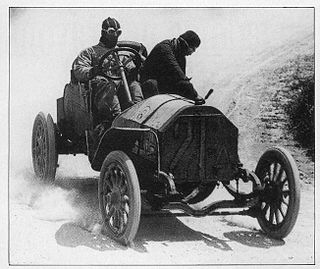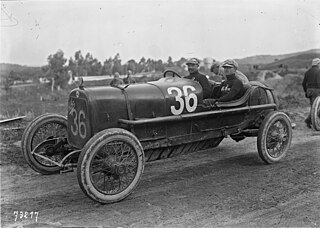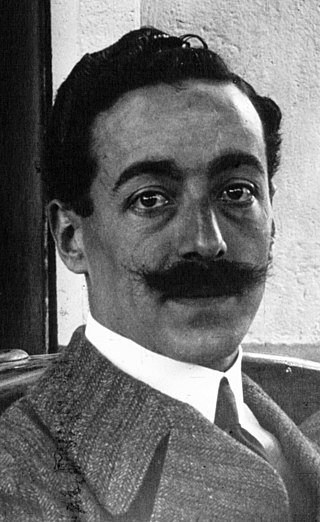
The Targa Florio was a public road endurance automobile race held in the mountains of Sicily near the island's capital of Palermo. Founded in 1906, it was the oldest sports car racing event, part of the World Sportscar Championship between 1955 and 1973. While the first races consisted of a whole tour of the island, the track length in the race's last decades was limited to the 72 km (45 mi) of the Circuito Piccolo delle Madonie, which was lapped 11 times.

Nino Vaccarella was an Italian sports car racing and Formula One driver.

The Coppa Florio was a motorsport race for automobiles first held in Italy in 1900. It was renamed in 1905 when Vincenzo Florio offered the initial 50,000 Lira prize money and a cup designed by Polak of Paris. The cup was to be awarded to the car maker who gained the most wins in the first seven races, beginning with the race held in 1905. In the event, the first seven races were all won by different manufacturers, but Peugeot won the eighth race in 1925 and thus secured the cup with its second win. However, the competition for the cup continued after Lucien Rosengart, then a director of Peugeot, offered to make it available again.

Vincenzo Florio Jr. was an Italian entrepreneur, heir of the rich Florio entrepreneurial dynasty, one of the wealthiest Italian families during the late 19th century. An automobile enthusiast, he is best known as the founder of the Targa Florio.

Ugo Sivocci was an Italian racing driver.
The 1906 Grand Prix season is regarded as the first Grand Prix racing season. It marked the advent of two iconic races: The French Grand Prix and the Targa Florio.
The 1907 Grand Prix season was the second Grand Prix racing season. It saw a blossoming of circuit events, with the shift from the inter-city races. The popularity of the inaugural French Grand Prix and Targa Florio saw those events held again. The new Kaiserpreis was the first major motor-race held in Germany. This year also saw a number of voiturette races as the number of specialist small-engine cars grew which gave close, exciting racing very popular with spectators.

The 1908 Grand Prix season was the third Grand Prix racing season. An international economic recession affected motor-racing with fewer races and smaller fields. However, in consequence, it also saw an increase in the number of smaller cars and voiturette racing. This gave close racing between the teams from Lion-Peugeot, Sizaire-Naudin and Delage. Both the major races in Europe, the Targa Florio and French Grand Prix, had precursor voiturette races, and along with the Coupe des Voiturettes, the honours were shared between those three manufacturers. This year’s Targa Florio had a small, but quality, field. Vincenzo Trucco won for Isotta-Fraschini with better mechanical reliability, after a close duel with the FIATs of Felice Nazzaro and Vincenzo Lancia.

The SCAT was an Italian automobile manufacturer from Turin, founded in 1906 by Giovanni Battista Ceirano.

The 1914 Grand Prix season consisted of Grand Prix races across Europe and the United States until abbreviated by the outbreak of World War I.

The 1923 Grand Prix season was part of a watershed year for motor racing that saw significant advances in motor-racing engineering, design and events. Fiat's chief designer, Guido Fornaca, developed the 805, the first supercharged car to win a Grand Prix. Benz appeared with the first mid-engined racer and, along with Bugatti and Voisin, produced some of the first efforts at aerodynamics on racing cars. With the United States also adopting the 2-litre formula, Harry Miller could use the smaller engine size to design the first single-seater race-car, ideally suited to American oval racing.

The Circuito delle Madonie was a road racing course made up of public roads, situated on the Italian island of Sicily, near the capital of Palermo, which hosted the famous Targa Florio event, between 1906 and 1977. The original public roads are still used today for the Targa Florio Rally successor event, which has been held since 1978. The course was made up of three different circuit length variations; the 72.00 km (44.74 mi) Piccolo short/small circuit, the slightly larger 108.0 km (67.1 mi) Medio medium circuit, and the full 148.821 km (92.473 mi) Grande circuit.

The 1909 Grand Prix season was the fourth Grand Prix racing season. There were no Grandes Épreuves that year, as the economic recession of the previous year continued on. Renault had withdrawn from motor-racing and a number of French manufacturers, falling behind the success of their German and Italian rivals, followed suit. The French Grand Prix was cancelled, leaving the Targa Florio in Italy and Vanderbilt Cup in the United States as the only major races this season. With so little competition and financial incentive, technological advances ground to a halt. Emphasis shifted from racing to setting speed and endurance records. Benz & Cie built a new 12.4-litre racing-engine, and its 200 bhp derivative was put into the Blitzen Benz. This 21.5-litre monster held the Land speed record from 1909 to 1922, with various drivers starting with Victor Hémery in November, 1909 at Brooklands.
The 1907 Targa Florio was a Grand Prix motor race held at Madonie on 22 April 1907. It was run over 3 laps of the 92.473 mile circuit, totaling 277.42 miles.

Alessandro Umberto Cagno, Umberto Cagno, nicknamed Sandrin was an Italian racing driver, Aviation pioneer and powerboat racer.

Hubert Le Blon was a French automobilist and pioneer aviator. He drove a steam-powered Gardner-Serpollet motorcar in the early 1900s, and then switched to Hotchkiss for both the world's first Grand Prix at Le Mans in France and the inaugural Targa Florio in Sicily. At the Vanderbilt Cup races on Long Island he competed for the US driving a Thomas.

Cyril Snipe (1888-1944) was a British motor racing driver who won the 1912 Targa Florio in Sicily driving an Italian SCAT motor car.

The 39a Targa Florio took place on 16 October, around the Circuito delle Madonie, Sicily, Italy. It was also the sixth and final round of the F.I.A. World Sports Car Championship as the Carrera Panamericana was cancelled and the Targa was allowed to take the late season slot, as a second Italian round after the Mille Miglia in May. The title lay between Ferrari, Jaguar and Mercedes-Benz, with Ferrari leading 19 points from one win to 16 from the other two marques which had two wins each, but no other results. Mercedes had skipped the first two heats and withdrew from Le Mans after the disaster, while leading the race. Jaguar did not show up in Sicily at the unknown 72 km long road track, but Mercedes came three weeks early to practice with seven cars. Finishing 1-2-4, Mercedes secured the championship.
The 42° Targa Florio took place on 11 May, on the Circuito Piccolo delle Madonie,. It was the third round of the 1958 World Sportscar Championship, which was running to new regulations introduced at the beginning of the season. The most influential of these regulations changes would be the 3.0 litre engine size limit. The event returned to the championship for the first time since 1955, following the demise of the Mille Miglia and the ban on road racing on mainland Italy. But such outcry did not deter Vincenzo Florio from holding his event on the traditional 45 mile mountainous circuit.
This article gives a general overview of motorsport in Italy. For a more exhaustive view see; Motorsport in Italy by decade and Motorsport in Italy by year. Motorsport is widely popular in Italy, and its history spans over a century back to the early 1900s. Today, Italy is considered a hub of motorsport in terms of racing venues, drivers, teams, and manufacturers. It hosts annual races across Formula One, MotoGP, the World Touring Car Cup, and other prominent motor racing series.














